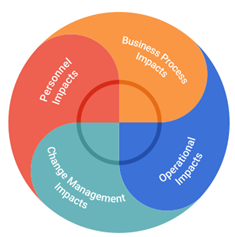Are you running on-premise back-office applications such as PeopleSoft, E-Business Suite, Lawson, JD Edwards, etc.? Are you looking for a strategy to move to a SaaS (Software-as a-Service) applications such as Oracle Cloud? Building trust into a cloud concept is not an easy feat and there are many items to consider as an organization develops a strategy and prepares for a SaaS transition.
First, the transition to SaaS is a business transformation, not just an IT infrastructure change or a pricing model change. It is not uncommon for businesses to underestimate the challenges and level of business transformation associated with moving to the cloud. When a SaaS strategy is created, the consequence of each choice should be incorporated into the strategy. By evaluating consequences, businesses can make sure the SaaS outcomes are clearly defined and understood across the organization. Essentially, this eliminates unnecessary surprises!
Second, businesses need to understand the impacts of the transition and set the right expectations. The transition impacts can be categorized as business process and policy, operational, change management, and personnel.

Business Process Impact – Organizations running on-premise applications are used to customizing their applications to meet business needs. With SaaS, business processes may need to be re-visited and adjusted in order to take advantage of the industry practices embedded in the Oracle Cloud applications.
Operational Impact – Organizations will need to rethink how to operate each function including internal employees, customer support, finance and accounting, and IT. With SaaS, some business functions no longer need internal support and business owners can see more flexibility and ownership compared to on-premise systems. M&A activity should also be thought through carefully as many industries will likely see more M&A activities in the coming years.
Change Management Impact – Companies should not underestimate the SaaS transition’s impact on their culture and people. SaaS applications bring change – change to IT functions, change to skillsets, change to expectations. It is important to include change management and organizational change aspects when transitioning to the SaaS model.
Personnel Impact – Internal IT teams will need to rethink how to support the new SaaS applications. This will likely include training and possible reorganization of the IT team. It is important to embrace and empower business owners and employees with the flexibility, ease of use, personalization, and analytics offered by leading SaaS solutions.
Third, transitioning to new technology is different for every business, however, there are always common factors including:
- Data integrity: The old data saying of “garbage in and garbage out” still holds true. Businesses should consider cleaning data prior to the SaaS move to ensure accuracy.
- Data retention strategy: Before the transition, it is important to decide how much data should be moved to the new system including the number of years of data and the types of data.
- Integration strategy: Many organizations have extensive system interfaces/integrations. It is important to evaluate these silo systems, see if they are still required, and if the business processes are included in the Oracle Cloud applications. Reducing the system integrations will reduce the total cost of ownership in the long run.
- Transition cost and resources: The level of effort for the transition differs based on the strategy. Some organizations may shy away from a SaaS transition due to concerns with the cost and availability of internal staff. It is important to remember that the SaaS transition is a journey and can provide a business with more competitive business advantages and ongoing improvements in the long run.
To learn more about moving your on-premise applications to Oracle Cloud applications, contact Sierra-Cedar for a complimentary cloud assessment workshop.
